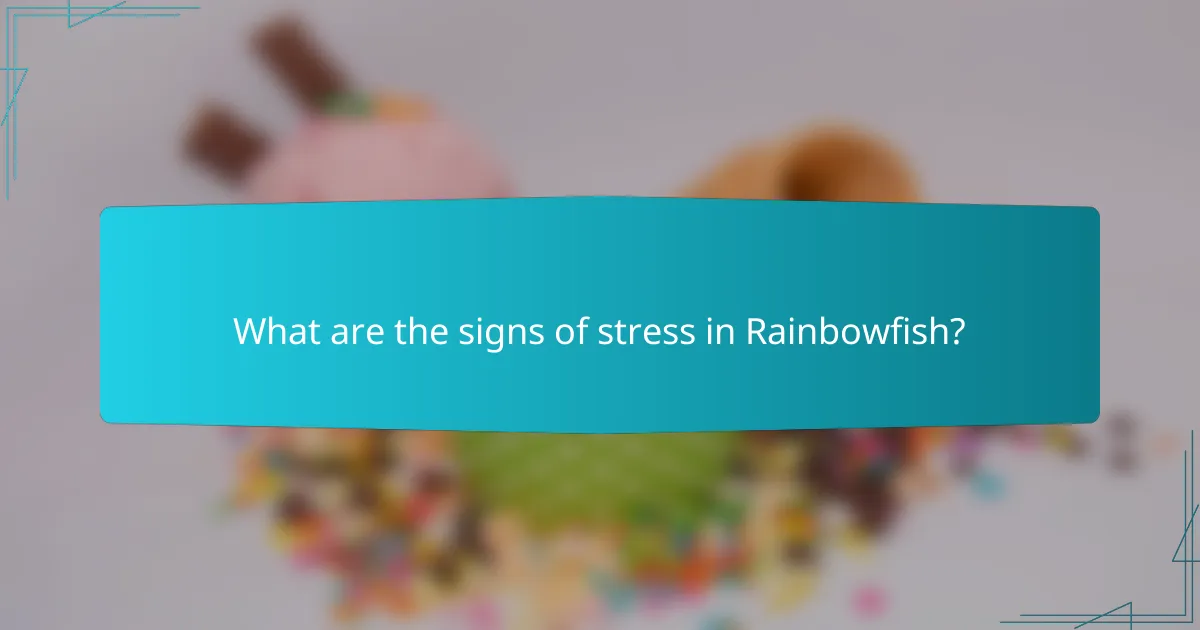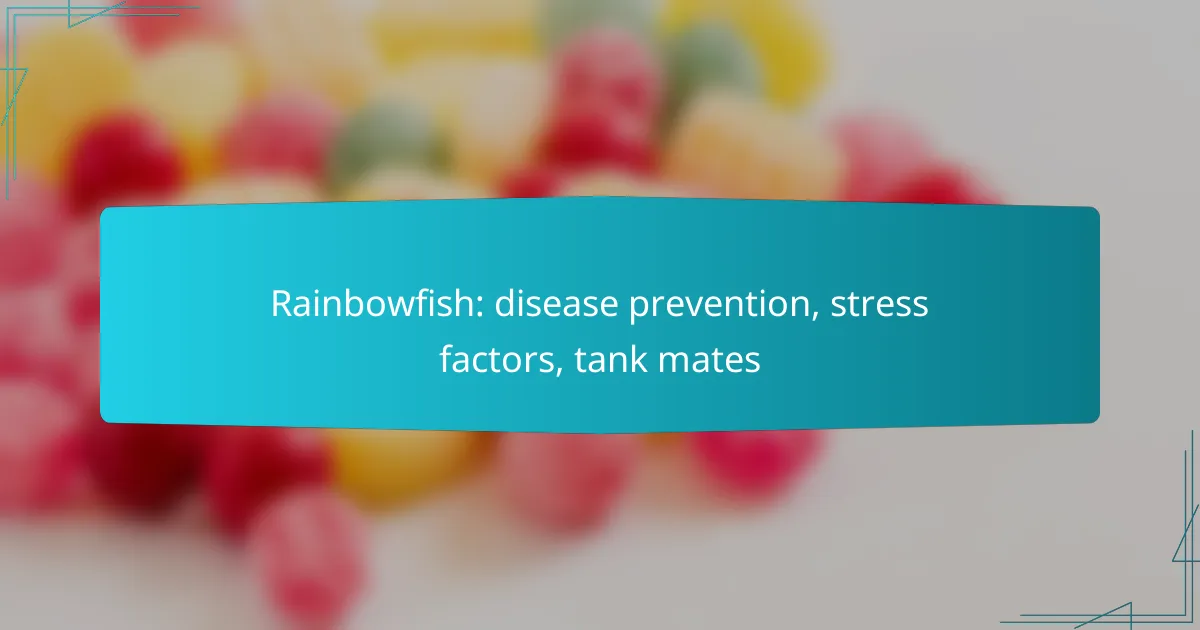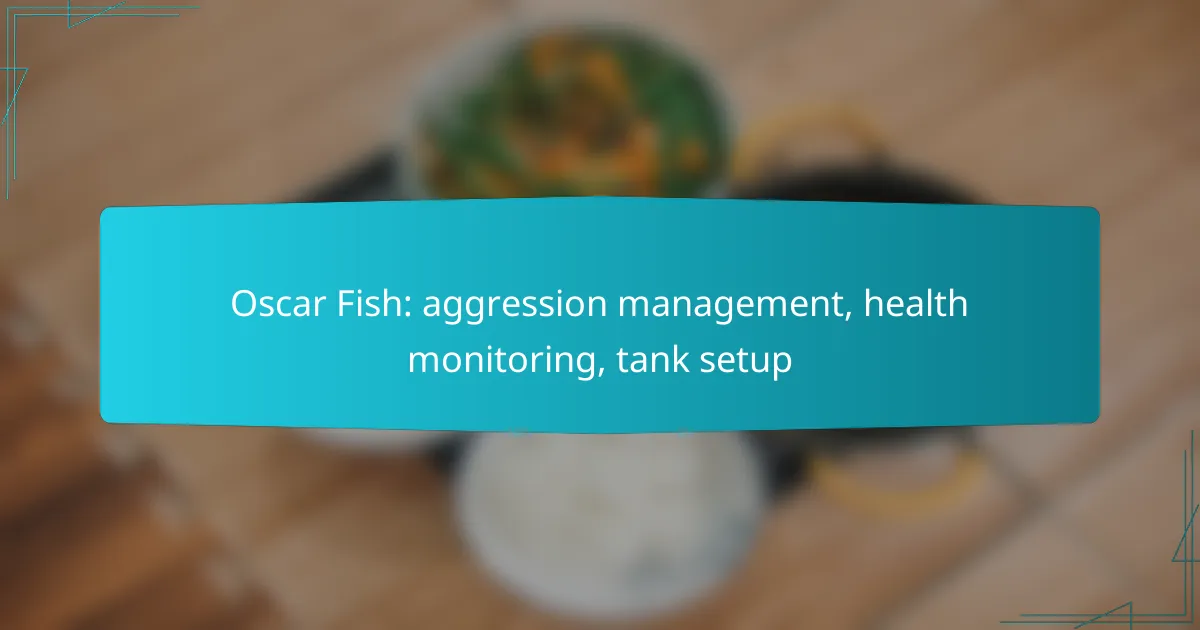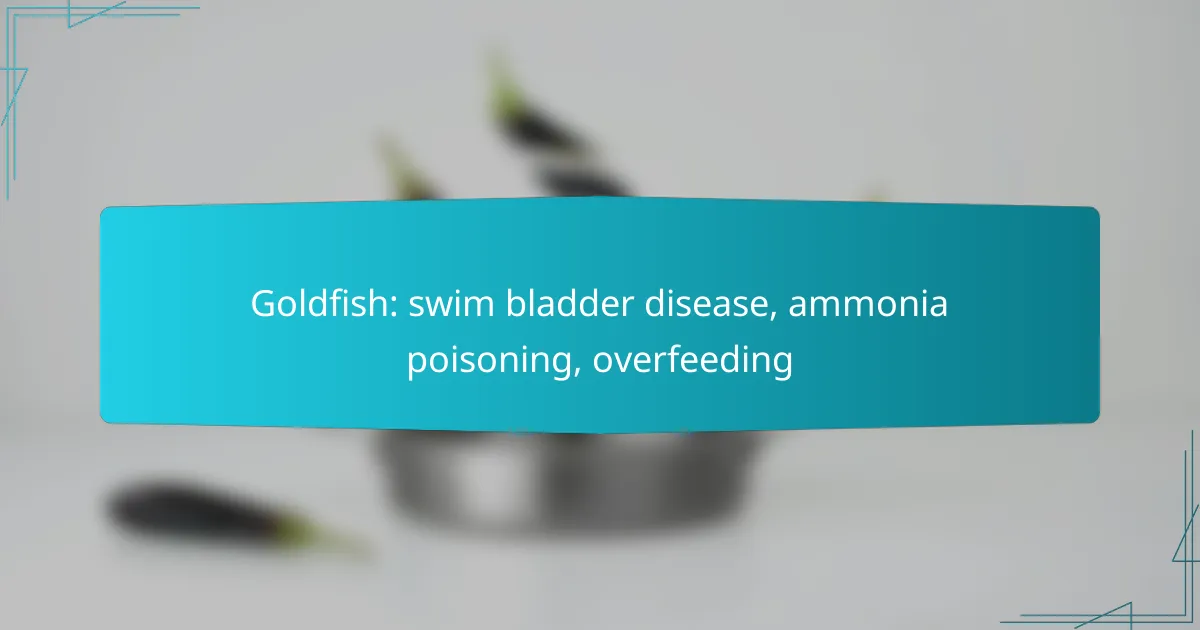Rainbowfish are vibrant and peaceful additions to community aquariums, but maintaining their health requires attention to disease prevention and stress factors. Optimal water conditions and careful tank maintenance are essential to minimize illness, while understanding potential stressors can enhance their well-being. Additionally, selecting compatible tank mates based on size and temperament is crucial for fostering a harmonious aquatic environment.

How to prevent diseases in Rainbowfish?
Preventing diseases in Rainbowfish involves maintaining optimal water conditions, ensuring proper tank upkeep, and being cautious with new additions to the aquarium. By following specific practices, you can significantly reduce the risk of illness in your fish.
Regular water quality testing
Regular water quality testing is crucial for preventing diseases in Rainbowfish. Test for parameters such as pH, ammonia, nitrite, and nitrate levels at least once a week. Keeping these levels within the ideal ranges will help maintain a healthy environment.
For Rainbowfish, a pH between 6.5 and 7.5, ammonia and nitrite levels at 0 ppm, and nitrate levels below 20 ppm are generally recommended. Use reliable test kits to monitor these factors consistently.
Proper tank maintenance
Proper tank maintenance is essential for disease prevention in Rainbowfish. This includes regular water changes, cleaning the substrate, and ensuring that filters are functioning well. Aim for a 10-20% water change weekly to keep the environment stable.
Additionally, remove uneaten food and waste promptly to prevent the buildup of harmful substances. Regularly check and clean equipment to avoid any malfunctions that could compromise water quality.
Quarantine new fish
Quarantining new fish before introducing them to your main tank is a vital step in disease prevention. Keep new arrivals in a separate tank for at least two weeks to monitor for signs of illness. This practice helps prevent the spread of diseases to your existing fish.
During quarantine, observe the new fish for any unusual behavior or symptoms, such as lethargy or discoloration. Treat any detected issues before adding them to the main aquarium.
Vaccination options
Currently, there are no specific vaccination options available for Rainbowfish. Instead, focus on preventive measures such as maintaining water quality and a stress-free environment. Healthy fish are less susceptible to diseases.
Research any emerging treatments or vaccines as the field of aquaculture evolves, but prioritize established preventive practices in the meantime.
Dietary supplements
Dietary supplements can enhance the health of Rainbowfish and help prevent diseases. A balanced diet rich in vitamins and minerals is essential for their immune system. Consider adding spirulina or other high-quality supplements to their diet.
Feed a varied diet that includes flakes, pellets, and live or frozen foods to ensure they receive all necessary nutrients. This approach supports their overall health and resilience against potential illnesses.

What are the common stress factors for Rainbowfish?
Rainbowfish can experience stress from various factors, which can negatively impact their health and behavior. Understanding these stressors is crucial for maintaining a thriving aquarium environment.
Inadequate tank size
Rainbowfish require ample swimming space to thrive, as they are active swimmers. A tank size of at least 100 liters (around 26 gallons) is recommended for a small group, allowing them to exhibit natural behaviors without feeling confined.
When selecting a tank, consider the number of fish you plan to keep. Insufficient space can lead to stress and aggression, ultimately affecting their health and longevity.
Poor water conditions
Maintaining optimal water conditions is vital for the well-being of Rainbowfish. They prefer slightly acidic to neutral pH levels (around 6.5 to 7.5) and stable temperatures between 24°C and 28°C (75°F to 82°F).
Regular water testing and changes are essential to prevent the buildup of harmful toxins. Aim for a weekly water change of about 10-20% to keep the environment clean and healthy.
Incompatible tank mates
Choosing compatible tank mates is crucial for reducing stress in Rainbowfish. They generally do well with other peaceful species but can become stressed if housed with aggressive or overly territorial fish.
Consider keeping them with species like tetras, rasboras, or other non-aggressive community fish. Avoid pairing them with larger predators or fin-nippers that may harass them.
Overcrowding
Overcrowding can lead to increased stress levels among Rainbowfish, as it limits their space and resources. A good rule of thumb is to allow at least 1 liter of water per centimeter of fish length to prevent overcrowding.
Monitor the fish population closely and be prepared to rehome or upgrade your tank if you notice signs of stress, such as aggressive behavior or reduced activity levels.

Which tank mates are compatible with Rainbowfish?
Rainbowfish are generally peaceful and can coexist with various species in a community tank. When selecting tank mates, consider the size, temperament, and environmental needs of each species to ensure a harmonious aquarium.
Neon Tetras
Neon Tetras are excellent companions for Rainbowfish due to their small size and peaceful nature. They thrive in similar water conditions, preferring slightly acidic to neutral pH levels and a temperature range of 22-26°C.
Keep in mind that Neon Tetras are schooling fish, so it’s best to keep them in groups of at least six to reduce stress and promote natural behavior. This also enhances the visual appeal of your aquarium.
Guppies
Guppies make compatible tank mates for Rainbowfish, as they share similar water preferences and are known for their vibrant colors. Guppies are hardy and can adapt to a range of conditions, making them easy to care for alongside Rainbowfish.
However, be cautious of overpopulation, as Guppies breed rapidly. Ensure a balanced male-to-female ratio to prevent stress and aggression among the fish.
Corydoras Catfish
Corydoras Catfish are bottom dwellers that coexist well with Rainbowfish. They help keep the tank clean by scavenging leftover food and debris, which can benefit the overall health of the aquarium.
These catfish prefer to be in groups, so aim for at least three to five individuals. They thrive in similar water conditions, with a preference for slightly acidic to neutral pH and a temperature range of 22-26°C.
Platies
Platies are another suitable option for tank mates with Rainbowfish, as they are peaceful and adaptable. They can tolerate a variety of water conditions and temperatures, making them a versatile addition to a community tank.
Like Guppies, Platies can breed easily, so monitor their population to maintain a balanced environment. Keeping a mix of males and females can help manage breeding and minimize stress among the fish.

What are the signs of stress in Rainbowfish?
Signs of stress in Rainbowfish include changes in behavior and physical appearance. Recognizing these signs early can help prevent serious health issues and improve the overall well-being of your fish.
Faded colors
Faded colors are a primary indicator of stress in Rainbowfish. When these fish are healthy and content, they exhibit vibrant hues; however, stress can cause their colors to dull significantly. This change may be due to poor water quality, inadequate tank conditions, or aggressive tank mates.
To address faded colors, ensure that the water parameters are within the ideal range for Rainbowfish, including temperature, pH, and hardness. Regular water changes and maintaining a clean tank environment can help restore their vivid coloration.
Erratic swimming
Erratic swimming behavior is another common sign of stress in Rainbowfish. Healthy fish typically swim gracefully and confidently, while stressed individuals may dart around the tank, swim in circles, or hide frequently. This behavior can indicate environmental stressors such as overcrowding, incompatible tank mates, or sudden changes in water conditions.
To mitigate erratic swimming, assess the tank’s population density and compatibility of the species present. Providing ample hiding spots and maintaining stable water conditions can help reduce stress and encourage more natural swimming patterns.










